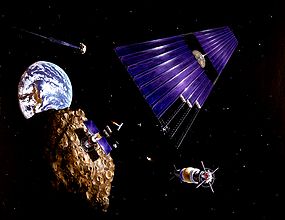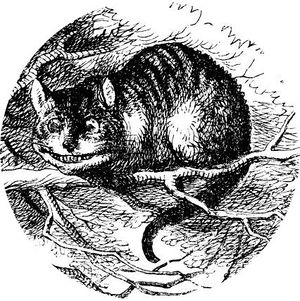Wonderland
| Wonderland Farm | |
 Wonderland Farm with its primary solar arrays deployed. Earth and L5 Station Island One can be seen in the background. | |
| Spacecraft Characteristics | |
|---|---|
| Base Hull | Rockhounds Space Rock SR-07 |
| Length | 950 m |
| Width | 600 m |
| Height | 720 m |
| Mass | 5.8 million mt |
| Drive Type | Gravity drive |
| Drive Rating | stationkeeping only[1] |
| Primary Manufacturer | Rockhounds, Inc. |
| Owner | Stellvia Corporation |
| Flag of Record | Stellvia |
| Faction | Stellvian |
| Registry Number | L5-U |
| Launched | 1 January 2013 |
| Purpose | Agribusiness |
| Primary Crew | Micheline Rouleau (chief administrator) Jerry Freedman (chief agronomist) Lea Meadows (chief apiarist) Sergy Gudanov (ship's doctor) |
| Other Crew | many, as-yet-unnamed |
| Auxillary Vehicles | many and various, including OGJ Troop Transport class ships Glennorth, Katase, and Otoyama as station shuttles and Roadrunner class ship Takumi F. as main cargo carrier |
| Operational Status | Active |
Formerly known as Rockhounds' Space Rock #7, Wonderland is the single largest post-OGJ source of produce for station Stellvia and the other stations at the Earth-Luna L5 point.
Contents
Known Ship's Quirks
None. Wonderland is primarily an asteroid, and its propulsion and artificial gravity are remarkably uniform.[2]
History
| “ | Earth is the only place you can get vegetables. | ” |
| —Alice (Arisa) Glennorth, Uchuu no Stellvia | ||
As much as Noah Scott likes that particular anime, this one line from it always bothered him. Why not grow vegetables in space? He quickly found out how impractical it was to grow more than a token amount of food crops in the disused nooks and crannies on his station, but he never completely abandoned the idea.
Finally, in October 2012, Stellvia Trading took possession of Rockhounds’ Space Rock #7. It was fully mined-out, with a maze of twisty little passages (all alike) throughout its body - ideal for widening and turning into huge caverns. His staff have enlarged the various chambers to the point that there are over two hundred acres of land available for cultivation, and handwaved the chambers so that they'd have earth-normal gravity and day-night cycles. Stellvia Trading also purchased topsoil from ’Daneside developers who were turning farmland into suburbs, and used it to turn the asteroid’s barren rock into farmland.
In recognition of needing to go down “rabbit holes” to get to the farms and in honour of Alice, Noah re-named the asteroid Wonderland when he officially opened it on January 1, 2013.
What's Down the Rabbit-Hole?
Wonderland’s largest chambers are usually devoted to grasses and similar plants; wheat, barley, quinoa, amaranth, rye, and maize are all in the collection to a greater or lesser degree. Smaller chambers hold beans, berries, edible flowers, and other vegetables - especially potatoes, tomatoes, cocoa beans, coffee bushes, sugar beets, blueberries, strawberries, raspberries, and roses. (Although the large chambers sometimes grow beans and the smaller ones sometimes grow grasses; chief agronomist Freedman knows the importance of crop rotation.) And there’s clover and beehives in all the farm chambers.
The smallest chambers are for long-term seed storage, short-term harvested food storage, dedicated agricultural experiments, compost and related processing and storage[3], and residences.
Chambers with handwaved crops are carefully isolated, with independent life-support systems and no internal access to the rest of Wonderland. One of those carefully-isolated chambers holds a single Soul of the Earth rose bush, one beehive, and a selection of clover, grasses, and ornamental roses. Leda Swansen is running an experiment to determine whether, and how quickly, handwavium spreads through pollination from ’waved plants to unwaved plants. (And the Jason is wondering what effect this has on the bees, and whether biomodded bees produce Mnemosyne's Honey, a particularly sweet version of Guacamole, both at the same time, or something else.) The Jason, the Professor, and A.C. Peters are all consultants on this experiment.
Wonderland’s chief agronomist, Jerry Freedman, doesn't believe in using GMOs; he can’t bank their seeds and use them the next growing cycle, and the controlled climates of Wonderland don't have any unwanted pests. Some of the staff suggested using “heirloom” breeds of vegetables and berries for their subtly different flavours, so there are a variety of breeds for many of the local plants in the asteroid's seed banks.
The farm does its best to not compete directly with Babylon .5; since that station is known for growing tropical fruits, Wonderland mostly stays out of that business.
Noteworthy Inhabitants
Micheline Rouleau is Wonderland’s chief administrator. Hired away from Air France, she spends her time directing traffic and pushing paper, rarely even visiting the farms.
Jerry Freedman is the asteroid’s chief agronomist. An old Kentucky boy who was happy to move to space permanently, he puts his agriculture degree to good use, ensuring Wonderland's ecosystems don’t go off-kilter.
Lea Meadows is Wonderland's chief apiarist. This ex-pat Canadian from southern Ontario keeps the bees happy, and the honey and beeswax supply flowing from Wonderland to Stellvia. She's obviously biomodded, with short antenna that pick up subtle changes in wind direction and air pressure (and make it impossible for her to wear a mass-produced spacesuit).
Sergy Gudanov is the facility’s doctor. He makes his services available to the other L5 habitats when he isn’t needed on Wonderland. Born and raised in Moscow, Dr. Gudanov didn't realize the folly of putting a half-acre (the entirety of one of the isolated chambers) of Blood Oranges under cultivation; he’s now happy to give them away, making Wonderland the largest supplier of Blood Oranges outside of the Jason himself after the Boskone War.
Competition, or lack thereof
Wonderland is an order of magnitude larger than most agribusinesses in Fenspace - only Grover's Corners, Babylon .5, and Yggdrasil come close to matching its output (although the farms of the Jovian subsystem out-produce all of the space-based agribusinesses put together). But the stations don't have as much overlap as one might expect:
- Grover’s Corners and the smaller “mom and pop” farms cater to individual Fen; Wonderland supplies food on an industrial scale, primarily for the Stellvia station complex. If you want a couple of cobs of corn for dinner once in a while, you head to Grover’s Corners; if you want a bushel of corn every day, you head to Wonderland. StellviaCorp avoids the retail end of the food business, preferring to act as a supplier to the S-Mart chain founded by Greenwood.
- Babylon .5 concentrates on tree fruits and tropical food plants; Wonderland concentrates on grains and legumes. (Grains, beans, berries, honey, beeswax, and sugar from the sugarbeets are what Wonderland has for sale; the potatoes, tomatoes, and coffee and cocoa beans are for station use.)
- Yggdrasil has a reputation (sometimes undeserved) of producing 'wave-enhanced produce; Wonderland prides itself on its 'wave-free produce.
Notes
- ↑ At least, that’s what the ship-registry databases say.
- ↑ It’s almost as if they were hardtech...
- ↑ Wonderland takes and processes most of Stellvia’s organic wastes for fertilizer
| ||||||||||||||||||||||||||||||||||||
| ||||||||
| ||||||||

